Analysis of Financial Statements and Investment Strategies Assignment
VerifiedAdded on 2020/03/13
|8
|2705
|78
Homework Assignment
AI Summary
This finance assignment provides a comprehensive analysis of key financial concepts. The solution begins with an overview of balance sheets and income statements, detailing their components and significance. It then differentiates between dividends and interest payments, highlighting their implications for shareholders and lenders. The assignment explores the concept of net working capital and its impact on a company's liquidity. Further, it includes calculations and interpretations of financial ratios such as current ratio and return on assets. The solution also covers investment analysis, including the impact of interest rates and time on investment growth. It delves into the calculation of rates of return, portfolio investment, and diversification strategies. The assignment provides practical examples and calculations to illustrate these concepts, offering a solid understanding of financial statement analysis and investment decision-making.
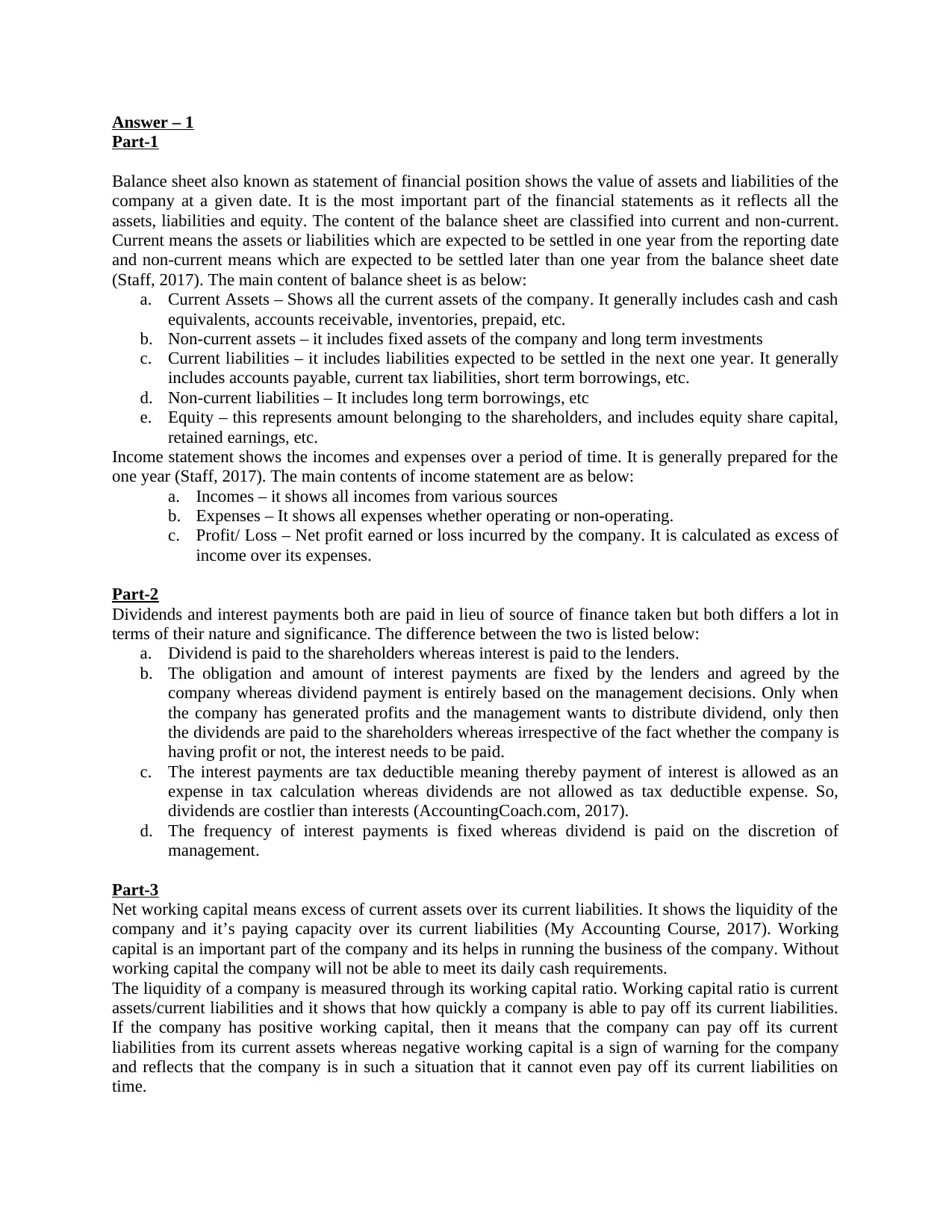
Answer – 1
Part-1
Balance sheet also known as statement of financial position shows the value of assets and liabilities of the
company at a given date. It is the most important part of the financial statements as it reflects all the
assets, liabilities and equity. The content of the balance sheet are classified into current and non-current.
Current means the assets or liabilities which are expected to be settled in one year from the reporting date
and non-current means which are expected to be settled later than one year from the balance sheet date
(Staff, 2017). The main content of balance sheet is as below:
a. Current Assets – Shows all the current assets of the company. It generally includes cash and cash
equivalents, accounts receivable, inventories, prepaid, etc.
b. Non-current assets – it includes fixed assets of the company and long term investments
c. Current liabilities – it includes liabilities expected to be settled in the next one year. It generally
includes accounts payable, current tax liabilities, short term borrowings, etc.
d. Non-current liabilities – It includes long term borrowings, etc
e. Equity – this represents amount belonging to the shareholders, and includes equity share capital,
retained earnings, etc.
Income statement shows the incomes and expenses over a period of time. It is generally prepared for the
one year (Staff, 2017). The main contents of income statement are as below:
a. Incomes – it shows all incomes from various sources
b. Expenses – It shows all expenses whether operating or non-operating.
c. Profit/ Loss – Net profit earned or loss incurred by the company. It is calculated as excess of
income over its expenses.
Part-2
Dividends and interest payments both are paid in lieu of source of finance taken but both differs a lot in
terms of their nature and significance. The difference between the two is listed below:
a. Dividend is paid to the shareholders whereas interest is paid to the lenders.
b. The obligation and amount of interest payments are fixed by the lenders and agreed by the
company whereas dividend payment is entirely based on the management decisions. Only when
the company has generated profits and the management wants to distribute dividend, only then
the dividends are paid to the shareholders whereas irrespective of the fact whether the company is
having profit or not, the interest needs to be paid.
c. The interest payments are tax deductible meaning thereby payment of interest is allowed as an
expense in tax calculation whereas dividends are not allowed as tax deductible expense. So,
dividends are costlier than interests (AccountingCoach.com, 2017).
d. The frequency of interest payments is fixed whereas dividend is paid on the discretion of
management.
Part-3
Net working capital means excess of current assets over its current liabilities. It shows the liquidity of the
company and it’s paying capacity over its current liabilities (My Accounting Course, 2017). Working
capital is an important part of the company and its helps in running the business of the company. Without
working capital the company will not be able to meet its daily cash requirements.
The liquidity of a company is measured through its working capital ratio. Working capital ratio is current
assets/current liabilities and it shows that how quickly a company is able to pay off its current liabilities.
If the company has positive working capital, then it means that the company can pay off its current
liabilities from its current assets whereas negative working capital is a sign of warning for the company
and reflects that the company is in such a situation that it cannot even pay off its current liabilities on
time.
Part-1
Balance sheet also known as statement of financial position shows the value of assets and liabilities of the
company at a given date. It is the most important part of the financial statements as it reflects all the
assets, liabilities and equity. The content of the balance sheet are classified into current and non-current.
Current means the assets or liabilities which are expected to be settled in one year from the reporting date
and non-current means which are expected to be settled later than one year from the balance sheet date
(Staff, 2017). The main content of balance sheet is as below:
a. Current Assets – Shows all the current assets of the company. It generally includes cash and cash
equivalents, accounts receivable, inventories, prepaid, etc.
b. Non-current assets – it includes fixed assets of the company and long term investments
c. Current liabilities – it includes liabilities expected to be settled in the next one year. It generally
includes accounts payable, current tax liabilities, short term borrowings, etc.
d. Non-current liabilities – It includes long term borrowings, etc
e. Equity – this represents amount belonging to the shareholders, and includes equity share capital,
retained earnings, etc.
Income statement shows the incomes and expenses over a period of time. It is generally prepared for the
one year (Staff, 2017). The main contents of income statement are as below:
a. Incomes – it shows all incomes from various sources
b. Expenses – It shows all expenses whether operating or non-operating.
c. Profit/ Loss – Net profit earned or loss incurred by the company. It is calculated as excess of
income over its expenses.
Part-2
Dividends and interest payments both are paid in lieu of source of finance taken but both differs a lot in
terms of their nature and significance. The difference between the two is listed below:
a. Dividend is paid to the shareholders whereas interest is paid to the lenders.
b. The obligation and amount of interest payments are fixed by the lenders and agreed by the
company whereas dividend payment is entirely based on the management decisions. Only when
the company has generated profits and the management wants to distribute dividend, only then
the dividends are paid to the shareholders whereas irrespective of the fact whether the company is
having profit or not, the interest needs to be paid.
c. The interest payments are tax deductible meaning thereby payment of interest is allowed as an
expense in tax calculation whereas dividends are not allowed as tax deductible expense. So,
dividends are costlier than interests (AccountingCoach.com, 2017).
d. The frequency of interest payments is fixed whereas dividend is paid on the discretion of
management.
Part-3
Net working capital means excess of current assets over its current liabilities. It shows the liquidity of the
company and it’s paying capacity over its current liabilities (My Accounting Course, 2017). Working
capital is an important part of the company and its helps in running the business of the company. Without
working capital the company will not be able to meet its daily cash requirements.
The liquidity of a company is measured through its working capital ratio. Working capital ratio is current
assets/current liabilities and it shows that how quickly a company is able to pay off its current liabilities.
If the company has positive working capital, then it means that the company can pay off its current
liabilities from its current assets whereas negative working capital is a sign of warning for the company
and reflects that the company is in such a situation that it cannot even pay off its current liabilities on
time.
Paraphrase This Document
Need a fresh take? Get an instant paraphrase of this document with our AI Paraphraser
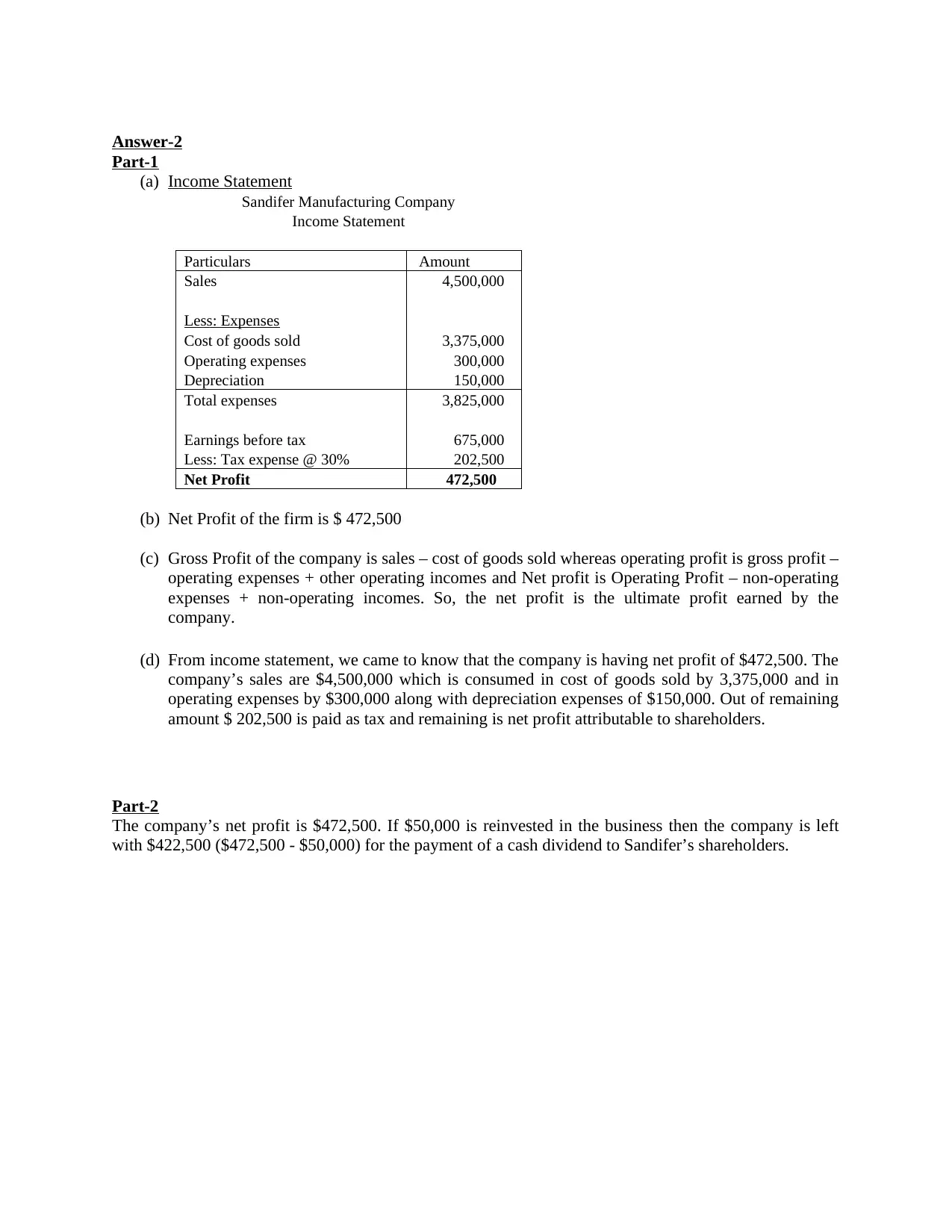
Answer-2
Part-1
(a) Income Statement
Sandifer Manufacturing Company
Income Statement
Particulars Amount
Sales 4,500,000
Less: Expenses
Cost of goods sold 3,375,000
Operating expenses 300,000
Depreciation 150,000
Total expenses 3,825,000
Earnings before tax 675,000
Less: Tax expense @ 30% 202,500
Net Profit 472,500
(b) Net Profit of the firm is $ 472,500
(c) Gross Profit of the company is sales – cost of goods sold whereas operating profit is gross profit –
operating expenses + other operating incomes and Net profit is Operating Profit – non-operating
expenses + non-operating incomes. So, the net profit is the ultimate profit earned by the
company.
(d) From income statement, we came to know that the company is having net profit of $472,500. The
company’s sales are $4,500,000 which is consumed in cost of goods sold by 3,375,000 and in
operating expenses by $300,000 along with depreciation expenses of $150,000. Out of remaining
amount $ 202,500 is paid as tax and remaining is net profit attributable to shareholders.
Part-2
The company’s net profit is $472,500. If $50,000 is reinvested in the business then the company is left
with $422,500 ($472,500 - $50,000) for the payment of a cash dividend to Sandifer’s shareholders.
Part-1
(a) Income Statement
Sandifer Manufacturing Company
Income Statement
Particulars Amount
Sales 4,500,000
Less: Expenses
Cost of goods sold 3,375,000
Operating expenses 300,000
Depreciation 150,000
Total expenses 3,825,000
Earnings before tax 675,000
Less: Tax expense @ 30% 202,500
Net Profit 472,500
(b) Net Profit of the firm is $ 472,500
(c) Gross Profit of the company is sales – cost of goods sold whereas operating profit is gross profit –
operating expenses + other operating incomes and Net profit is Operating Profit – non-operating
expenses + non-operating incomes. So, the net profit is the ultimate profit earned by the
company.
(d) From income statement, we came to know that the company is having net profit of $472,500. The
company’s sales are $4,500,000 which is consumed in cost of goods sold by 3,375,000 and in
operating expenses by $300,000 along with depreciation expenses of $150,000. Out of remaining
amount $ 202,500 is paid as tax and remaining is net profit attributable to shareholders.
Part-2
The company’s net profit is $472,500. If $50,000 is reinvested in the business then the company is left
with $422,500 ($472,500 - $50,000) for the payment of a cash dividend to Sandifer’s shareholders.
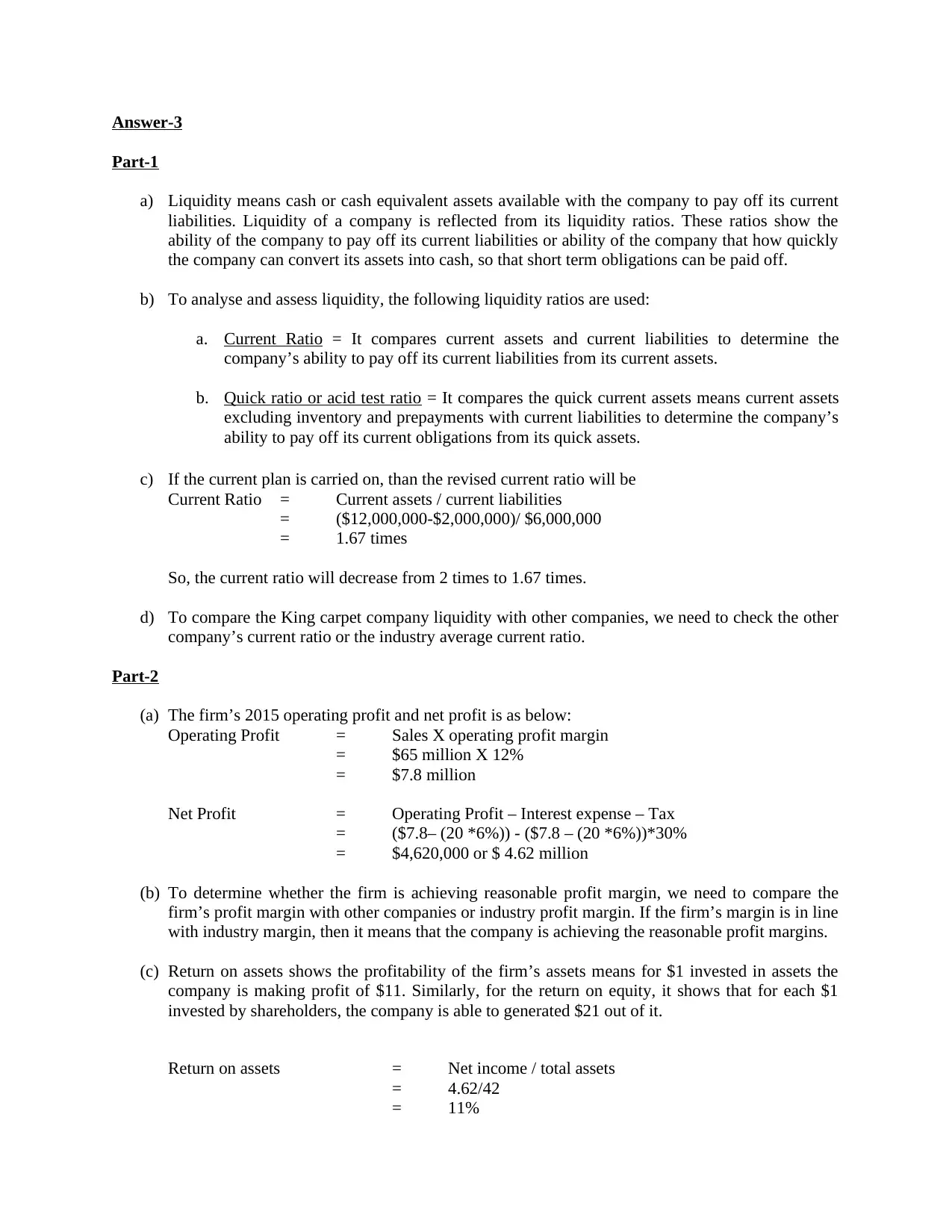
Answer-3
Part-1
a) Liquidity means cash or cash equivalent assets available with the company to pay off its current
liabilities. Liquidity of a company is reflected from its liquidity ratios. These ratios show the
ability of the company to pay off its current liabilities or ability of the company that how quickly
the company can convert its assets into cash, so that short term obligations can be paid off.
b) To analyse and assess liquidity, the following liquidity ratios are used:
a. Current Ratio = It compares current assets and current liabilities to determine the
company’s ability to pay off its current liabilities from its current assets.
b. Quick ratio or acid test ratio = It compares the quick current assets means current assets
excluding inventory and prepayments with current liabilities to determine the company’s
ability to pay off its current obligations from its quick assets.
c) If the current plan is carried on, than the revised current ratio will be
Current Ratio = Current assets / current liabilities
= ($12,000,000-$2,000,000)/ $6,000,000
= 1.67 times
So, the current ratio will decrease from 2 times to 1.67 times.
d) To compare the King carpet company liquidity with other companies, we need to check the other
company’s current ratio or the industry average current ratio.
Part-2
(a) The firm’s 2015 operating profit and net profit is as below:
Operating Profit = Sales X operating profit margin
= $65 million X 12%
= $7.8 million
Net Profit = Operating Profit – Interest expense – Tax
= ($7.8– (20 *6%)) - ($7.8 – (20 *6%))*30%
= $4,620,000 or $ 4.62 million
(b) To determine whether the firm is achieving reasonable profit margin, we need to compare the
firm’s profit margin with other companies or industry profit margin. If the firm’s margin is in line
with industry margin, then it means that the company is achieving the reasonable profit margins.
(c) Return on assets shows the profitability of the firm’s assets means for $1 invested in assets the
company is making profit of $11. Similarly, for the return on equity, it shows that for each $1
invested by shareholders, the company is able to generated $21 out of it.
Return on assets = Net income / total assets
= 4.62/42
= 11%
Part-1
a) Liquidity means cash or cash equivalent assets available with the company to pay off its current
liabilities. Liquidity of a company is reflected from its liquidity ratios. These ratios show the
ability of the company to pay off its current liabilities or ability of the company that how quickly
the company can convert its assets into cash, so that short term obligations can be paid off.
b) To analyse and assess liquidity, the following liquidity ratios are used:
a. Current Ratio = It compares current assets and current liabilities to determine the
company’s ability to pay off its current liabilities from its current assets.
b. Quick ratio or acid test ratio = It compares the quick current assets means current assets
excluding inventory and prepayments with current liabilities to determine the company’s
ability to pay off its current obligations from its quick assets.
c) If the current plan is carried on, than the revised current ratio will be
Current Ratio = Current assets / current liabilities
= ($12,000,000-$2,000,000)/ $6,000,000
= 1.67 times
So, the current ratio will decrease from 2 times to 1.67 times.
d) To compare the King carpet company liquidity with other companies, we need to check the other
company’s current ratio or the industry average current ratio.
Part-2
(a) The firm’s 2015 operating profit and net profit is as below:
Operating Profit = Sales X operating profit margin
= $65 million X 12%
= $7.8 million
Net Profit = Operating Profit – Interest expense – Tax
= ($7.8– (20 *6%)) - ($7.8 – (20 *6%))*30%
= $4,620,000 or $ 4.62 million
(b) To determine whether the firm is achieving reasonable profit margin, we need to compare the
firm’s profit margin with other companies or industry profit margin. If the firm’s margin is in line
with industry margin, then it means that the company is achieving the reasonable profit margins.
(c) Return on assets shows the profitability of the firm’s assets means for $1 invested in assets the
company is making profit of $11. Similarly, for the return on equity, it shows that for each $1
invested by shareholders, the company is able to generated $21 out of it.
Return on assets = Net income / total assets
= 4.62/42
= 11%
⊘ This is a preview!⊘
Do you want full access?
Subscribe today to unlock all pages.

Trusted by 1+ million students worldwide
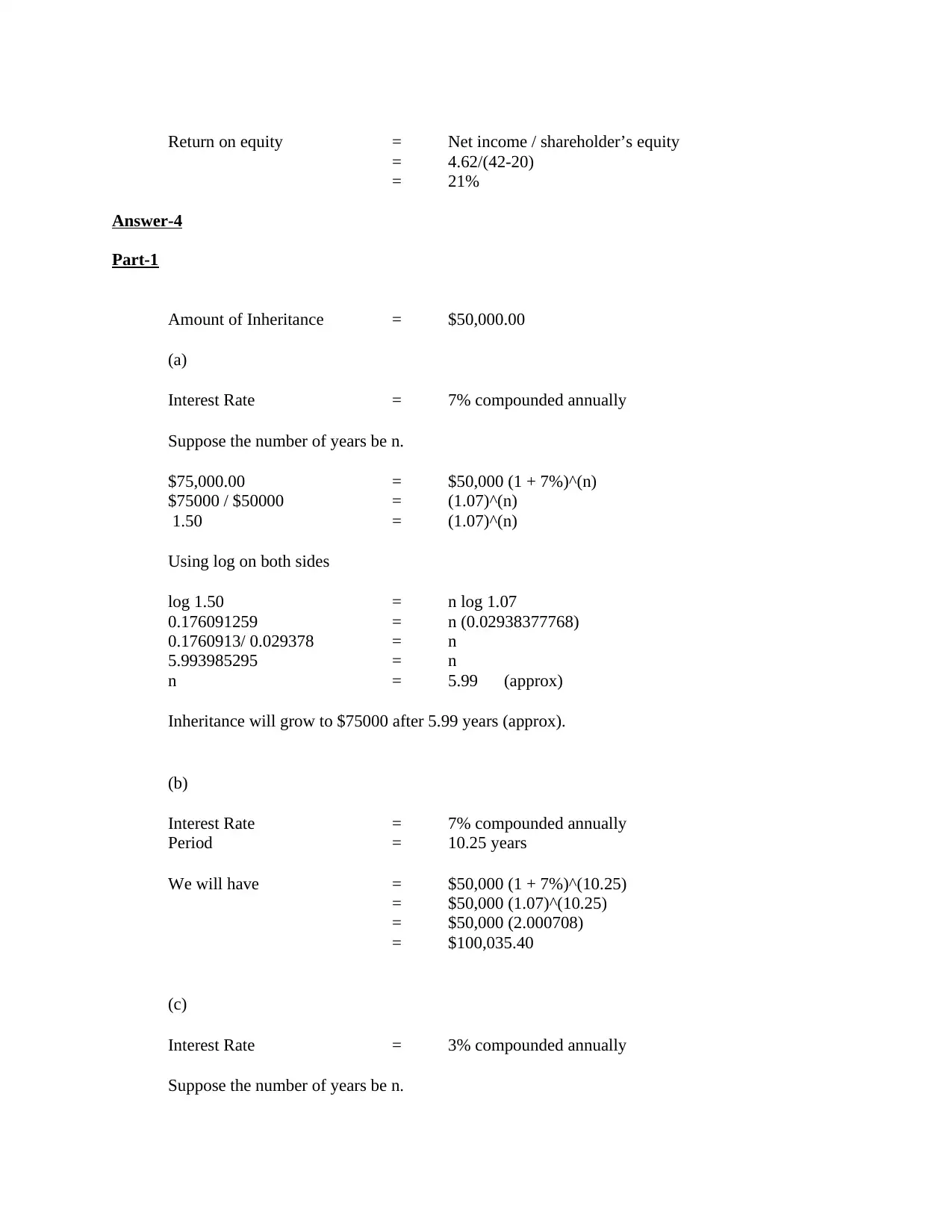
Return on equity = Net income / shareholder’s equity
= 4.62/(42-20)
= 21%
Answer-4
Part-1
Amount of Inheritance = $50,000.00
(a)
Interest Rate = 7% compounded annually
Suppose the number of years be n.
$75,000.00 = $50,000 (1 + 7%)^(n)
$75000 / $50000 = (1.07)^(n)
1.50 = (1.07)^(n)
Using log on both sides
log 1.50 = n log 1.07
0.176091259 = n (0.02938377768)
0.1760913/ 0.029378 = n
5.993985295 = n
n = 5.99 (approx)
Inheritance will grow to $75000 after 5.99 years (approx).
(b)
Interest Rate = 7% compounded annually
Period = 10.25 years
We will have = $50,000 (1 + 7%)^(10.25)
= $50,000 (1.07)^(10.25)
= $50,000 (2.000708)
= $100,035.40
(c)
Interest Rate = 3% compounded annually
Suppose the number of years be n.
= 4.62/(42-20)
= 21%
Answer-4
Part-1
Amount of Inheritance = $50,000.00
(a)
Interest Rate = 7% compounded annually
Suppose the number of years be n.
$75,000.00 = $50,000 (1 + 7%)^(n)
$75000 / $50000 = (1.07)^(n)
1.50 = (1.07)^(n)
Using log on both sides
log 1.50 = n log 1.07
0.176091259 = n (0.02938377768)
0.1760913/ 0.029378 = n
5.993985295 = n
n = 5.99 (approx)
Inheritance will grow to $75000 after 5.99 years (approx).
(b)
Interest Rate = 7% compounded annually
Period = 10.25 years
We will have = $50,000 (1 + 7%)^(10.25)
= $50,000 (1.07)^(10.25)
= $50,000 (2.000708)
= $100,035.40
(c)
Interest Rate = 3% compounded annually
Suppose the number of years be n.
Paraphrase This Document
Need a fresh take? Get an instant paraphrase of this document with our AI Paraphraser
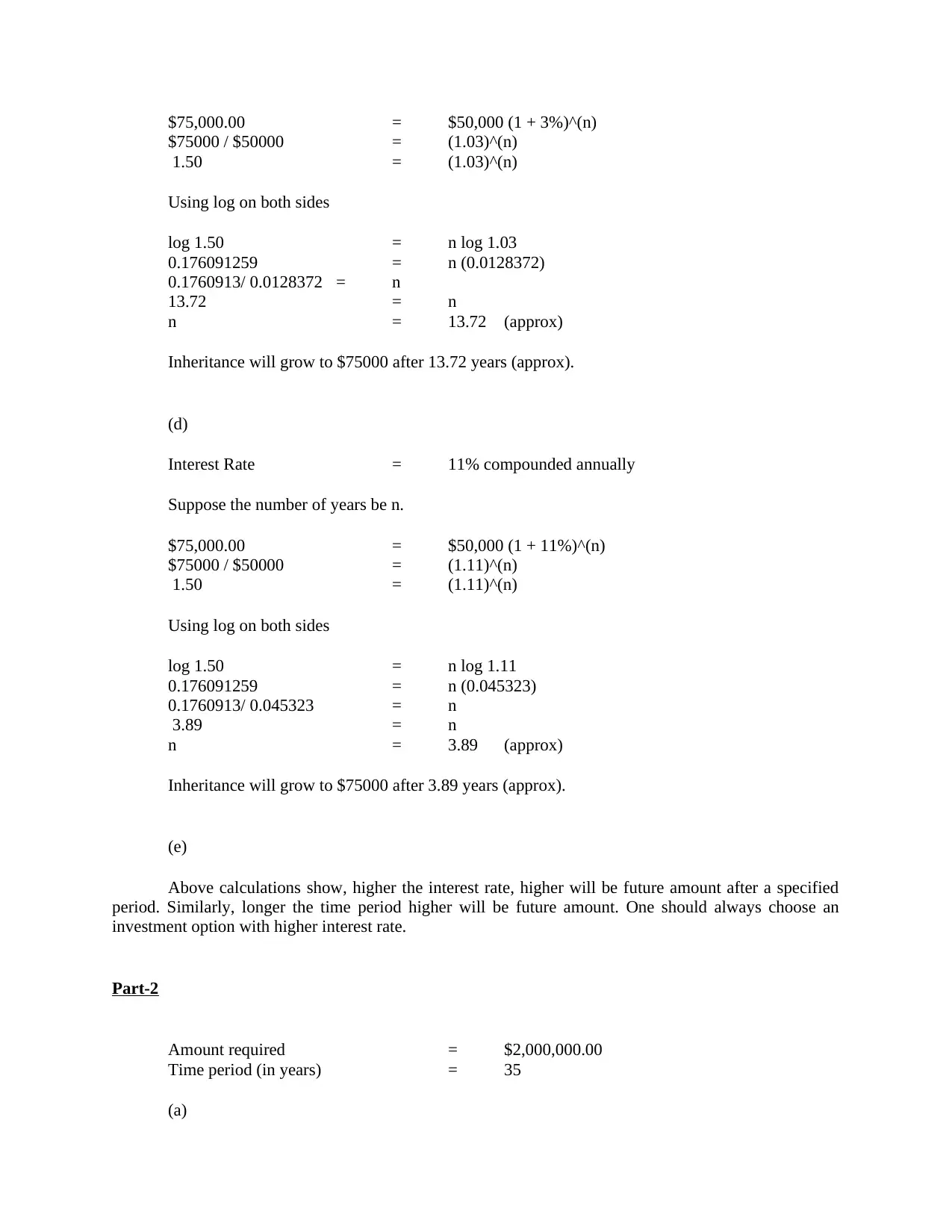
$75,000.00 = $50,000 (1 + 3%)^(n)
$75000 / $50000 = (1.03)^(n)
1.50 = (1.03)^(n)
Using log on both sides
log 1.50 = n log 1.03
0.176091259 = n (0.0128372)
0.1760913/ 0.0128372 = n
13.72 = n
n = 13.72 (approx)
Inheritance will grow to $75000 after 13.72 years (approx).
(d)
Interest Rate = 11% compounded annually
Suppose the number of years be n.
$75,000.00 = $50,000 (1 + 11%)^(n)
$75000 / $50000 = (1.11)^(n)
1.50 = (1.11)^(n)
Using log on both sides
log 1.50 = n log 1.11
0.176091259 = n (0.045323)
0.1760913/ 0.045323 = n
3.89 = n
n = 3.89 (approx)
Inheritance will grow to $75000 after 3.89 years (approx).
(e)
Above calculations show, higher the interest rate, higher will be future amount after a specified
period. Similarly, longer the time period higher will be future amount. One should always choose an
investment option with higher interest rate.
Part-2
Amount required = $2,000,000.00
Time period (in years) = 35
(a)
$75000 / $50000 = (1.03)^(n)
1.50 = (1.03)^(n)
Using log on both sides
log 1.50 = n log 1.03
0.176091259 = n (0.0128372)
0.1760913/ 0.0128372 = n
13.72 = n
n = 13.72 (approx)
Inheritance will grow to $75000 after 13.72 years (approx).
(d)
Interest Rate = 11% compounded annually
Suppose the number of years be n.
$75,000.00 = $50,000 (1 + 11%)^(n)
$75000 / $50000 = (1.11)^(n)
1.50 = (1.11)^(n)
Using log on both sides
log 1.50 = n log 1.11
0.176091259 = n (0.045323)
0.1760913/ 0.045323 = n
3.89 = n
n = 3.89 (approx)
Inheritance will grow to $75000 after 3.89 years (approx).
(e)
Above calculations show, higher the interest rate, higher will be future amount after a specified
period. Similarly, longer the time period higher will be future amount. One should always choose an
investment option with higher interest rate.
Part-2
Amount required = $2,000,000.00
Time period (in years) = 35
(a)
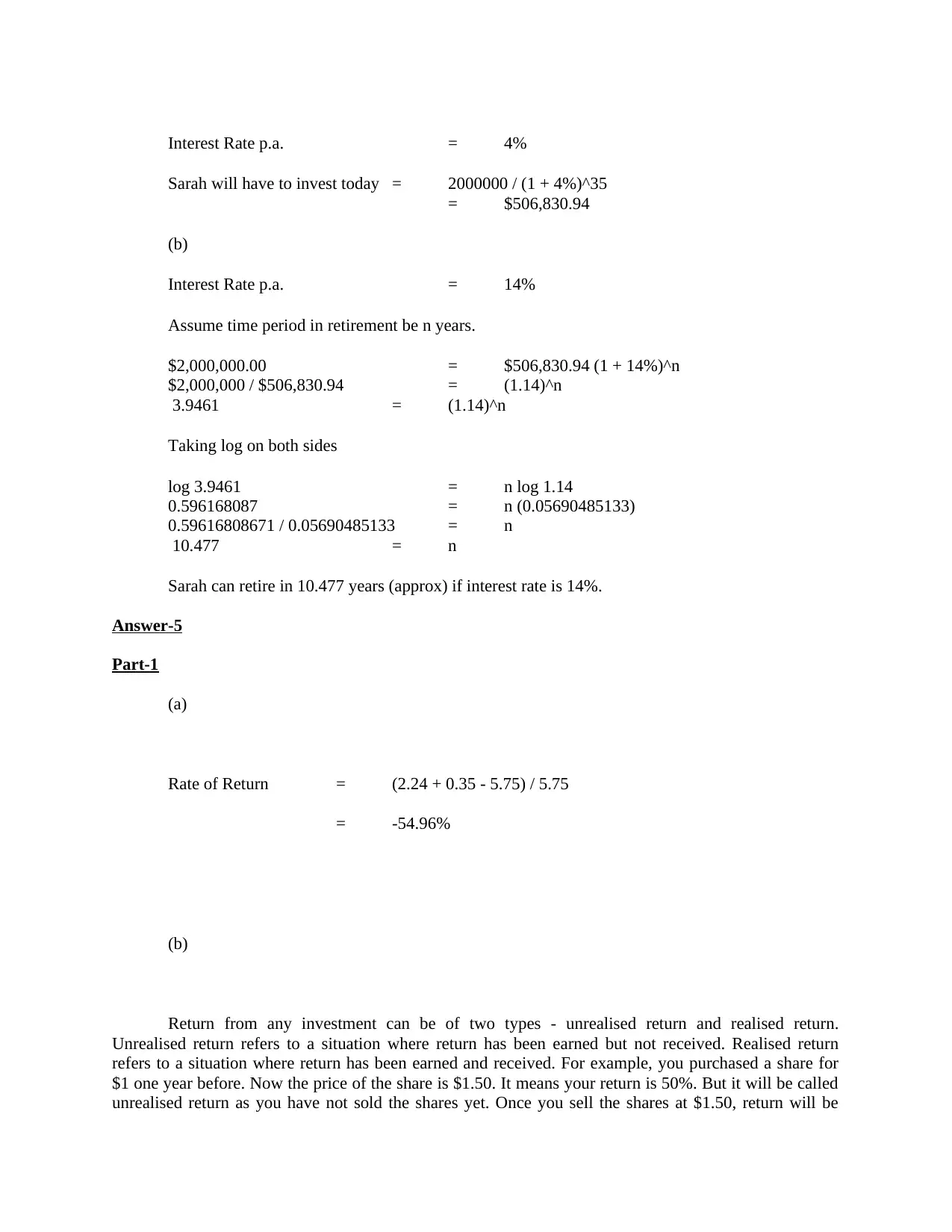
Interest Rate p.a. = 4%
Sarah will have to invest today = 2000000 / (1 + 4%)^35
= $506,830.94
(b)
Interest Rate p.a. = 14%
Assume time period in retirement be n years.
$2,000,000.00 = $506,830.94 (1 + 14%)^n
$2,000,000 / $506,830.94 = (1.14)^n
3.9461 = (1.14)^n
Taking log on both sides
log 3.9461 = n log 1.14
0.596168087 = n (0.05690485133)
0.59616808671 / 0.05690485133 = n
10.477 = n
Sarah can retire in 10.477 years (approx) if interest rate is 14%.
Answer-5
Part-1
(a)
Rate of Return = (2.24 + 0.35 - 5.75) / 5.75
= -54.96%
(b)
Return from any investment can be of two types - unrealised return and realised return.
Unrealised return refers to a situation where return has been earned but not received. Realised return
refers to a situation where return has been earned and received. For example, you purchased a share for
$1 one year before. Now the price of the share is $1.50. It means your return is 50%. But it will be called
unrealised return as you have not sold the shares yet. Once you sell the shares at $1.50, return will be
Sarah will have to invest today = 2000000 / (1 + 4%)^35
= $506,830.94
(b)
Interest Rate p.a. = 14%
Assume time period in retirement be n years.
$2,000,000.00 = $506,830.94 (1 + 14%)^n
$2,000,000 / $506,830.94 = (1.14)^n
3.9461 = (1.14)^n
Taking log on both sides
log 3.9461 = n log 1.14
0.596168087 = n (0.05690485133)
0.59616808671 / 0.05690485133 = n
10.477 = n
Sarah can retire in 10.477 years (approx) if interest rate is 14%.
Answer-5
Part-1
(a)
Rate of Return = (2.24 + 0.35 - 5.75) / 5.75
= -54.96%
(b)
Return from any investment can be of two types - unrealised return and realised return.
Unrealised return refers to a situation where return has been earned but not received. Realised return
refers to a situation where return has been earned and received. For example, you purchased a share for
$1 one year before. Now the price of the share is $1.50. It means your return is 50%. But it will be called
unrealised return as you have not sold the shares yet. Once you sell the shares at $1.50, return will be
⊘ This is a preview!⊘
Do you want full access?
Subscribe today to unlock all pages.

Trusted by 1+ million students worldwide
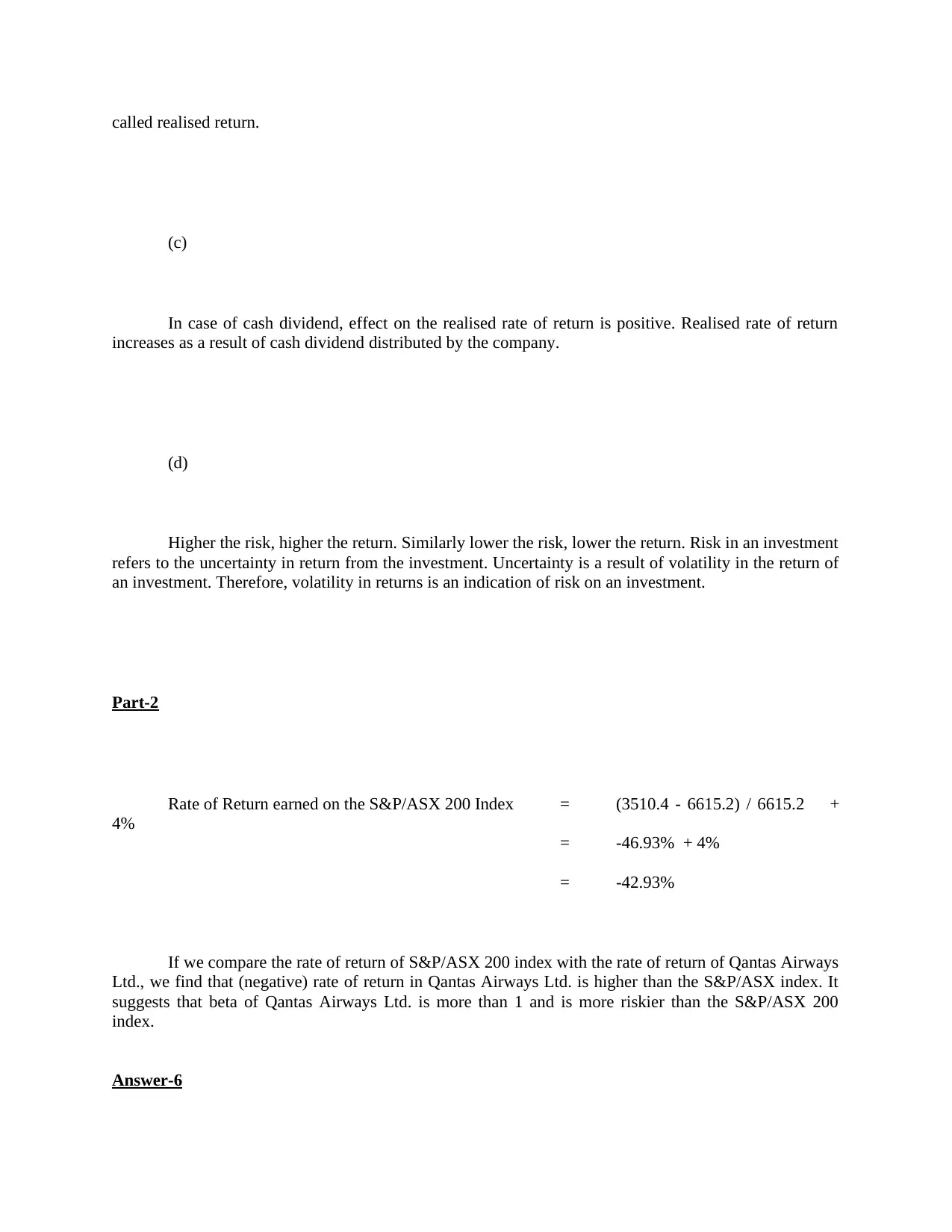
called realised return.
(c)
In case of cash dividend, effect on the realised rate of return is positive. Realised rate of return
increases as a result of cash dividend distributed by the company.
(d)
Higher the risk, higher the return. Similarly lower the risk, lower the return. Risk in an investment
refers to the uncertainty in return from the investment. Uncertainty is a result of volatility in the return of
an investment. Therefore, volatility in returns is an indication of risk on an investment.
Part-2
Rate of Return earned on the S&P/ASX 200 Index = (3510.4 - 6615.2) / 6615.2 +
4%
= -46.93% + 4%
= -42.93%
If we compare the rate of return of S&P/ASX 200 index with the rate of return of Qantas Airways
Ltd., we find that (negative) rate of return in Qantas Airways Ltd. is higher than the S&P/ASX index. It
suggests that beta of Qantas Airways Ltd. is more than 1 and is more riskier than the S&P/ASX 200
index.
Answer-6
(c)
In case of cash dividend, effect on the realised rate of return is positive. Realised rate of return
increases as a result of cash dividend distributed by the company.
(d)
Higher the risk, higher the return. Similarly lower the risk, lower the return. Risk in an investment
refers to the uncertainty in return from the investment. Uncertainty is a result of volatility in the return of
an investment. Therefore, volatility in returns is an indication of risk on an investment.
Part-2
Rate of Return earned on the S&P/ASX 200 Index = (3510.4 - 6615.2) / 6615.2 +
4%
= -46.93% + 4%
= -42.93%
If we compare the rate of return of S&P/ASX 200 index with the rate of return of Qantas Airways
Ltd., we find that (negative) rate of return in Qantas Airways Ltd. is higher than the S&P/ASX index. It
suggests that beta of Qantas Airways Ltd. is more than 1 and is more riskier than the S&P/ASX 200
index.
Answer-6
Paraphrase This Document
Need a fresh take? Get an instant paraphrase of this document with our AI Paraphraser
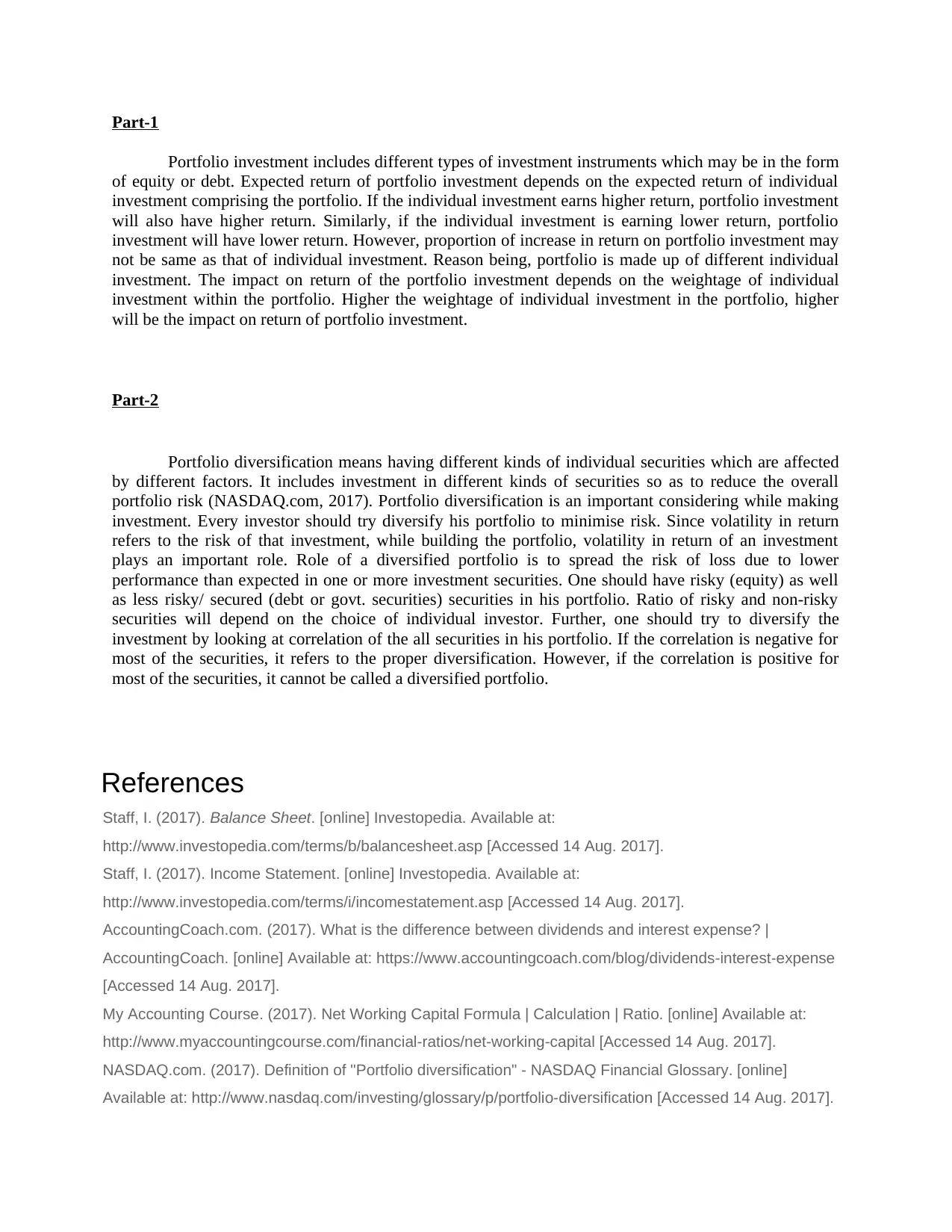
Part-1
Portfolio investment includes different types of investment instruments which may be in the form
of equity or debt. Expected return of portfolio investment depends on the expected return of individual
investment comprising the portfolio. If the individual investment earns higher return, portfolio investment
will also have higher return. Similarly, if the individual investment is earning lower return, portfolio
investment will have lower return. However, proportion of increase in return on portfolio investment may
not be same as that of individual investment. Reason being, portfolio is made up of different individual
investment. The impact on return of the portfolio investment depends on the weightage of individual
investment within the portfolio. Higher the weightage of individual investment in the portfolio, higher
will be the impact on return of portfolio investment.
Part-2
Portfolio diversification means having different kinds of individual securities which are affected
by different factors. It includes investment in different kinds of securities so as to reduce the overall
portfolio risk (NASDAQ.com, 2017). Portfolio diversification is an important considering while making
investment. Every investor should try diversify his portfolio to minimise risk. Since volatility in return
refers to the risk of that investment, while building the portfolio, volatility in return of an investment
plays an important role. Role of a diversified portfolio is to spread the risk of loss due to lower
performance than expected in one or more investment securities. One should have risky (equity) as well
as less risky/ secured (debt or govt. securities) securities in his portfolio. Ratio of risky and non-risky
securities will depend on the choice of individual investor. Further, one should try to diversify the
investment by looking at correlation of the all securities in his portfolio. If the correlation is negative for
most of the securities, it refers to the proper diversification. However, if the correlation is positive for
most of the securities, it cannot be called a diversified portfolio.
References
Staff, I. (2017). Balance Sheet. [online] Investopedia. Available at:
http://www.investopedia.com/terms/b/balancesheet.asp [Accessed 14 Aug. 2017].
Staff, I. (2017). Income Statement. [online] Investopedia. Available at:
http://www.investopedia.com/terms/i/incomestatement.asp [Accessed 14 Aug. 2017].
AccountingCoach.com. (2017). What is the difference between dividends and interest expense? |
AccountingCoach. [online] Available at: https://www.accountingcoach.com/blog/dividends-interest-expense
[Accessed 14 Aug. 2017].
My Accounting Course. (2017). Net Working Capital Formula | Calculation | Ratio. [online] Available at:
http://www.myaccountingcourse.com/financial-ratios/net-working-capital [Accessed 14 Aug. 2017].
NASDAQ.com. (2017). Definition of "Portfolio diversification" - NASDAQ Financial Glossary. [online]
Available at: http://www.nasdaq.com/investing/glossary/p/portfolio-diversification [Accessed 14 Aug. 2017].
Portfolio investment includes different types of investment instruments which may be in the form
of equity or debt. Expected return of portfolio investment depends on the expected return of individual
investment comprising the portfolio. If the individual investment earns higher return, portfolio investment
will also have higher return. Similarly, if the individual investment is earning lower return, portfolio
investment will have lower return. However, proportion of increase in return on portfolio investment may
not be same as that of individual investment. Reason being, portfolio is made up of different individual
investment. The impact on return of the portfolio investment depends on the weightage of individual
investment within the portfolio. Higher the weightage of individual investment in the portfolio, higher
will be the impact on return of portfolio investment.
Part-2
Portfolio diversification means having different kinds of individual securities which are affected
by different factors. It includes investment in different kinds of securities so as to reduce the overall
portfolio risk (NASDAQ.com, 2017). Portfolio diversification is an important considering while making
investment. Every investor should try diversify his portfolio to minimise risk. Since volatility in return
refers to the risk of that investment, while building the portfolio, volatility in return of an investment
plays an important role. Role of a diversified portfolio is to spread the risk of loss due to lower
performance than expected in one or more investment securities. One should have risky (equity) as well
as less risky/ secured (debt or govt. securities) securities in his portfolio. Ratio of risky and non-risky
securities will depend on the choice of individual investor. Further, one should try to diversify the
investment by looking at correlation of the all securities in his portfolio. If the correlation is negative for
most of the securities, it refers to the proper diversification. However, if the correlation is positive for
most of the securities, it cannot be called a diversified portfolio.
References
Staff, I. (2017). Balance Sheet. [online] Investopedia. Available at:
http://www.investopedia.com/terms/b/balancesheet.asp [Accessed 14 Aug. 2017].
Staff, I. (2017). Income Statement. [online] Investopedia. Available at:
http://www.investopedia.com/terms/i/incomestatement.asp [Accessed 14 Aug. 2017].
AccountingCoach.com. (2017). What is the difference between dividends and interest expense? |
AccountingCoach. [online] Available at: https://www.accountingcoach.com/blog/dividends-interest-expense
[Accessed 14 Aug. 2017].
My Accounting Course. (2017). Net Working Capital Formula | Calculation | Ratio. [online] Available at:
http://www.myaccountingcourse.com/financial-ratios/net-working-capital [Accessed 14 Aug. 2017].
NASDAQ.com. (2017). Definition of "Portfolio diversification" - NASDAQ Financial Glossary. [online]
Available at: http://www.nasdaq.com/investing/glossary/p/portfolio-diversification [Accessed 14 Aug. 2017].
1 out of 8
Related Documents
Your All-in-One AI-Powered Toolkit for Academic Success.
+13062052269
info@desklib.com
Available 24*7 on WhatsApp / Email
![[object Object]](/_next/static/media/star-bottom.7253800d.svg)
Unlock your academic potential
Copyright © 2020–2025 A2Z Services. All Rights Reserved. Developed and managed by ZUCOL.




